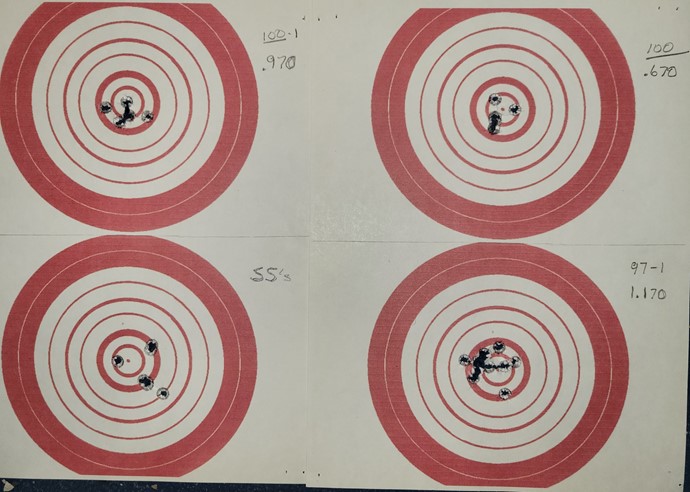Larry Gibson
posted this
07 January 2022
I guess I am a crusher/jammer as over the years I've come to believe seating the drive band or ogive slightly into the leade (ball seat by some definitions) is more accurate. However, I've no real empirical data proving accuracy is better. As I went to the range yesterday to pressure test some 35 Rem loads in my M91 Mauser I like to take another rifle along to shoot while waiting for the test rifle barrel to cool between tests. Thus, I took the M70 target .308W along with a few of the 30 XCB target loads for it.
The M70 is a stock PF stainless that shot 1/2 moa with 175 MKs over Varget back when I was shooting 600 - 1000 yard belly matches. It has about 2500 such jacketed rounds through it. I only use it for cast bullets these days though occasionally (pre COVD anyway) getting over to Phoenix for a CBA match. I use the weight sorted 30 XCB cast of #2 alloy, WQ'd, Hornady GCs sized at .311 (they drop at .3105) the sized .310 in a honed out Lee sizer. They are loaded to a "crush" fit oal over 16.5 gr of 2400 (no filler) in LC Match cases with the flash holes drilled out and fully match prepped. The cases are fire formed and neck sized in a Redding NS dies with a Lyman 31 M die used to expand the neck to .002 neck tension and flare the case mouth. The velocity runs 1788 fps with the SDs (10 shots) running 5 fps +/- and the ES running under 20 fps.
I use the "SAAMI Twist" method of putting the loaded round into the rifle.
I had not shot the M70 for some time which was previous to my cataract surgery. Thus, I needed to adjust the scope so the vertical crosshair of the Leupold 6.5x20 target scope was vertical and had to refocus the ocular lens. I figured both would slightly affect the zero slightly and it did. I put 4 CBA score bulls up at 100 yards. I the fired 6 shots on the "SS" bull (bottom left) after putting 2 shots into the berm to foul the bore. 1st three shots were low right, so I adjusted up 3 click and the next two shots cut each other slightly high right. I went down one click and left one click and put the 6th shot into the 10 ring. Went back to the test rifle for another test string.
Came back to the M70 and shot the 5 shot group on the upper left target. The nine o'clock 10 is the first shot from the cold bore. I always fire a fouler before shooting a string for score in CBA matches as that first shot is usually slightly out of the group, as we see. Went back to the test rifle letting the M70 "cool".
I then shot the five shot group on the upper right target. the first shot is the low ten, again just slightly out of the group. Back to the test rifle letting the M70 cool again.
Next i shot a 5 shot group on the lower right target. Those five are the five center shots over the ten ring with the first cold bore shot being the low nine. Back to the test rifle giving the M70 a cool down.
When I came back to shoot the last five shots a steady 2-3 MPH wind had started coming from 3-4 o'clock. I did not hold for the wind as i wanted to see how much wind drift there would be. The first cold bore shot is the nine out at nine o'clock with the other four cutting the slanted hole on the edge of the 10 ring at 9 o'clock. My past experience with such a wind is to hold on the 10 ring at 3 o'clock. That would have been perfect this time also.
Average group size for the 4 five shot groups was .823" Was a good day testing the 35 Rem and shooting the M70.

Concealment is not cover.........

.jpg?width=50&crop=0,0,50,50)














